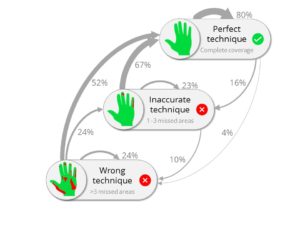Why repeated hand hygiene trainings are mandatory? How big problem skill retention is? One of our major clinical studies (Lehotsky et al. 2015) aimed to answer these questions.
The focus of the study was to investigate the change in hand hygiene technique of healthcare workers (HCW) over time. Hand hygiene effectiveness was measured by the Semmelweis Scanner, and immediate, objective visual feedback was provided to each user. Using the fluorescent method, the number of insufficiently disinfected areas were identified on the hand surface. Hand hygiene technique was considered ‘wrong’, if more than 3 areas were missed, or ‘inaccurate’, if there were 1–3 missed areas on HCW’s hand. In the case of ‘perfect’ technique, hands were fully covered by the handrub [1].
 Figure 1: Effect of repeated feedback on healthcare workers’ hand hygiene technique.
Figure 1: Effect of repeated feedback on healthcare workers’ hand hygiene technique.
136 HCW from 3 European hospitals were involved in the study. As presented in Figure 1, if the previous hand hygiene event was inaccurate after providing objective feedback with the Semmelweis Scanner, there is 67% probability that the next hand hygiene event will be flawless. This means natural learning based on our mistakes. There is a 23% probability that the repeated hand hygiene technique will stay inaccurate, and a slight chance (10%) that it will become worse. A ‘perfect technique’ event is 80% likely to be followed by another ‘perfect technique’ event, but there is 20% probability that the previously perfect technique falls behind [1]. This is the phenomenon called skill retention, meaning that a previously acquired skill is maintained through time [2].

Figure 2: Effect of continuous monitoring and immediate feedback on hand hygiene technique.
The study also investigated how repetitive feedback changes hand hygiene performance. Figure 2 shows that hand hygiene failure rate (either inaccurate or wrong technique) dropped significantly; from the initial 49.3% to 13.3% by the fifth observation, confirming that repetitive feedback can improve hand hygiene technique [1].
Conclusion:
Direct feedback on hand hygiene technique by the Semmelweis Scanner improves hand hygiene over time. Skill retention is threatening important issue, calling for continuous training to improve and maintain hand hygiene. Constant presence of a monitoring device in hospital wards could be beneficial in this regard.
Read our previous post on how to handrub, how to apply the fluorescent method and electronic compliance monitoring systems.